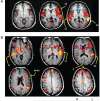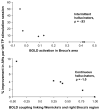Probing the pathophysiology of auditory/verbal hallucinations by combining functional magnetic resonance imaging and transcranial magnetic stimulation
- PMID: 17298962
- PMCID: PMC2634833
- DOI: 10.1093/cercor/bhl183
Probing the pathophysiology of auditory/verbal hallucinations by combining functional magnetic resonance imaging and transcranial magnetic stimulation
Abstract
Functional magnetic resonance imaging and repetitive transcranial magnetic stimulation (rTMS) were used to explore the pathophysiology of auditory/verbal hallucinations (AVHs). Sixteen patients with schizophrenia-spectrum disorder were studied with continuous or near continuous AVHs. For patients with intermittent hallucinations (N = 8), blood oxygenation level-dependent (BOLD) activation maps comparing hallucination and nonhallucination periods were generated. For patients with continuous hallucinations (N = 8) correlations between BOLD signal time course in Wernicke's area, and other regions were used to map functional coupling to the former. These maps were used to identify 3-6 cortical sites per patient that were probed with 1-Hz rTMS and sham stimulation. Delivering rTMS to left temporoparietal sites in Wernicke's area and the adjacent supramarginal gyrus was accompanied by a greater rate of AVH improvement compared with sham stimulation and rTMS delivered to anterior temporal sites. For intermittent hallucinators, lower levels of hallucination-related activation in Broca's area strongly predicted greater rate of response to left temporoparietal rTMS. For continuous hallucinators, reduced coupling between Wernicke's and a right homologue of Broca's area strongly predicted greater left temporoparietal rTMS rate of response. These findings suggest that dominant hemisphere temporoparietal areas are involved in expressing AVHs, with higher levels of coactivation and/or coupling involving inferior frontal regions reinforcing underlying pathophysiology.
Figures







Similar articles
-
Auditory/Verbal hallucinations, speech perception neurocircuitry, and the social deafferentation hypothesis.Clin EEG Neurosci. 2008 Apr;39(2):87-90. doi: 10.1177/155005940803900213. Clin EEG Neurosci. 2008. PMID: 18450175 Clinical Trial.
-
Effects of low frequency rTMS treatment on brain networks for inner speech in patients with schizophrenia and auditory verbal hallucinations.Prog Neuropsychopharmacol Biol Psychiatry. 2017 Aug 1;78:105-113. doi: 10.1016/j.pnpbp.2017.04.017. Epub 2017 Apr 22. Prog Neuropsychopharmacol Biol Psychiatry. 2017. PMID: 28442422 Clinical Trial.
-
When Broca goes uninformed: reduced information flow to Broca's area in schizophrenia patients with auditory hallucinations.Schizophr Bull. 2013 Sep;39(5):1087-95. doi: 10.1093/schbul/sbs107. Epub 2012 Oct 15. Schizophr Bull. 2013. PMID: 23070537 Free PMC article.
-
Cortical activations during auditory verbal hallucinations in schizophrenia: a coordinate-based meta-analysis.Am J Psychiatry. 2011 Jan;168(1):73-81. doi: 10.1176/appi.ajp.2010.09101522. Epub 2010 Oct 15. Am J Psychiatry. 2011. PMID: 20952459
-
[The use of repetitive transcranial magnetic stimulation (rTMS) in auditory verbal hallucinations (AVH)].Fortschr Neurol Psychiatr. 2010 Nov;78(11):632-43. doi: 10.1055/s-0029-1245499. Epub 2010 Jul 20. Fortschr Neurol Psychiatr. 2010. PMID: 20648414 Review. German.
Cited by
-
Hyper-Activated Brain Resting-State Network and Mismatch Negativity Deficit in Schizophrenia With Auditory Verbal Hallucination Revealed by an Event-Related Potential Evidence.Front Psychiatry. 2020 Aug 3;11:765. doi: 10.3389/fpsyt.2020.00765. eCollection 2020. Front Psychiatry. 2020. PMID: 32903707 Free PMC article.
-
Bilateral Repetitive Transcranial Magnetic Stimulation for Auditory Hallucinations in Patients with Schizophrenia: A Randomized Controlled, Cross-over Study.Clin Psychopharmacol Neurosci. 2014 Dec;12(3):222-8. doi: 10.9758/cpn.2014.12.3.222. Epub 2014 Dec 26. Clin Psychopharmacol Neurosci. 2014. PMID: 25598827 Free PMC article.
-
Cognitive Enhancement via Network-Targeted Cortico-cortical Associative Brain Stimulation.Cereb Cortex. 2020 Mar 14;30(3):1516-1527. doi: 10.1093/cercor/bhz182. Cereb Cortex. 2020. PMID: 31667497 Free PMC article.
-
Auditory hallucinations in schizophrenia: the role of cognitive, brain structural and genetic disturbances in the left temporal lobe.Front Hum Neurosci. 2008 Mar 28;1:6. doi: 10.3389/neuro.09.006.2007. eCollection 2007. Front Hum Neurosci. 2008. PMID: 18958220 Free PMC article.
-
Are Auditory Hallucinations Related to the Brain's Resting State Activity? A 'Neurophenomenal Resting State Hypothesis'.Clin Psychopharmacol Neurosci. 2014 Dec;12(3):189-95. doi: 10.9758/cpn.2014.12.3.189. Epub 2014 Dec 26. Clin Psychopharmacol Neurosci. 2014. PMID: 25598821 Free PMC article. Review.
References
-
- Andreasen NC, Flaum M. Schizophrenia: the characteristic symptoms. Schizophr Bull. 1991;17:27–50. - PubMed
-
- Badier JM, Chauvel P. Spatio-temporal characteristics of paroxysmal interictal events in human temporal lobe epilepsy. J Physiol (Paris) 1995;89:255–264. - PubMed
-
- Benson RR, Whalen DH, Richardson M, Swainson B, Clark VP, Lai S, Liberman AM. Parametrically dissociating speech and nonspeech perception in the brain using fMRI. Brain Lang. 2001;78:364–396. - PubMed
-
- Biswal BB, Yetkin FZ, Haughton VM, Hyde JS. Functional connectivity in the motor cortex of resting human brain using echo-planar MRI. Magn Reson Med. 1995;34:537–541. - PubMed
-
- Boroojerdi B, Prager A, Muelibacher W, Cohen LG. Reduction of human visual cortex excitability using 1-Hz transcranial magnetic stimulation. Neurology. 2000;54:1529–1531. - PubMed

